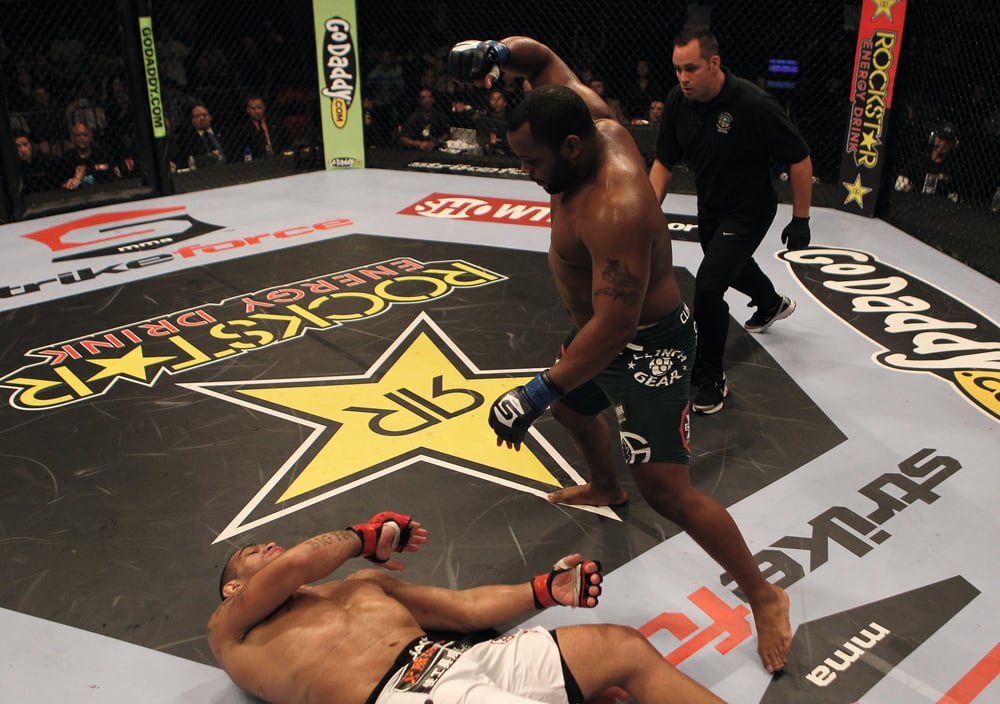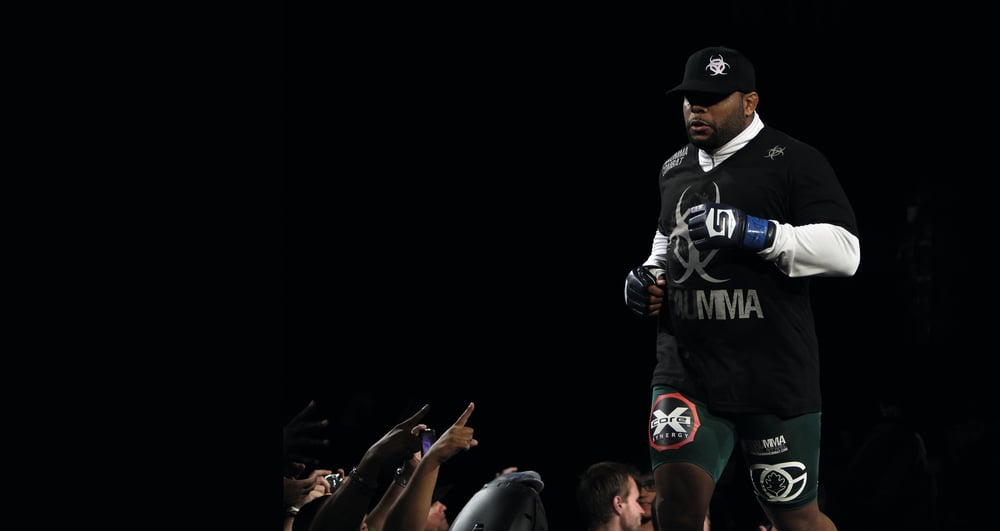
Issue 083
December 2011
Strikeforce heavyweight tournament finalist Daniel Cormier might be flying high now, but the 9-0 former Oklahoma State wrestler has fought through more adversity in 32 years than most people experience in a lifetime…
NEED TO KNOW
NAME: DANIEL CORMIER
AGE: 32
STARTED: 2009
TEAM: AKA
DIVISION: Heavyweight
STYLE: Wrestling, kickboxing
RECORD: 9-0
Louisiana native Daniel Cormier is no stranger to adversity. The Olympic wrestler, from Lafayette, who just punched his way to an upset knockout victory over Antonio ‘Bigfoot’ Silva in Strikeforce’s heavyweight grand prix, has known tragedy and heartbreak few could grapple with. The blows he dealt with such precision and daring against the massive Brazilian pale in comparison to the bombardment he has endured in his personal life.
At the age of seven, the 32-year-old’s father, Joseph, was shot and killed on a bleak Thanksgiving Day in 1986. On an annual occasion when millions of Americans give thanks for their many blessings, the young Cormier learned that he no longer had a dad. In 2003, his daughter, Kaeydin Imri Cormier, was tragically killed in a car accident. Soon after, a close friend and a cousin were also killed in car wrecks. Then Cormier’s college roommate, Daniel Lawson, died in a plane crash that killed 10 members of the Oklahoma State basketball team.
And how did he rebound from a series of tragedies? By representing the United States in freestyle wrestling at the Olympics and becoming one of the most talked-about talents in mixed martial arts today.
“I find motivation in everything,” explains Cormier, who has amassed a spotless 9-0 record in two years. “I’m not a guy that is going to sit there and let it (his personal tragedies) kill me. I’ve had a great support system my entire life, from my father passing when I was a little kid. My family was really there for me when my daughter passed; my ex played a big part in helping me to recover. My coach, John Smith, was really there for me… I use these people that I lost as my guardians, as my angels. My daughter Kaeydin goes to that cage with me every time. When I was wrestling she was sitting on the side of the mat watching her dad compete. Every time I go in that cage I feel like she’s right there watching me.
“I have this great picture of my son. I was doing a photo shoot the other day and he was just grabbing onto the cage watching and staring at us and that symbolizes to me what I imagine my daughter would be doing every time I compete.”
Despite the heart-wrenching turbulence, after only two years in MMA, Cormier has already cracked the top 10 in the heavyweight division and is set to face Josh Barnett in the Strikeforce grand prix final, after stepping in as an alternate after Alistair Overeem’s withdrawal. His ascent through top level wrestling ranks was no less impressive. It all began on a soggy football field down on the Bayou.
“It’s a funny story, man. I started wrestling because I lived right across the street from the high school. Me and my friend were across the street playing football. We were kind of tussling and the high school wrestling coach (Stephen ‘Tank’ Lotief) saw us and told us to stop fighting with each other and do something positive and try wrestling. We saw them wrestling and went over to find out what it was all about. The dude told us to get into the ‘neutral position’ and we were like, ‘What the hell is that?’ (laughs). Hey, it sucked at first but we stuck with it.”

After an illustrious high-school wrestling career at Northside High in Lafayette, that included three Division 1 state championships and a third-place finish in the entire nation, there was a stint at Colby Community College. There he won the Junior College National Championship twice. Big-time college wrestling at Oklahoma State followed – walking in the footsteps of legendary Randy Couture amongst a host of others. His reasons for going to Oklahoma were simple.
“Honestly, man, that’s where they were winning at,” Cormier says. “If you watch and pay attention to the decisions that I’ve made in regards to my career, whether it be wrestling or fighting I don’t really necessarily do the popular thing.” Daniel’s referring both to his choosing of American Kickboxing Academy (AKA) over Las Vegas or Southern California gyms to learn the MMA trade, as well as opting for a lack of distractions in Oklahoma over a deeply storied wrestling college like Iowa.
“A lot of MMA guys came out of Oklahoma and Arizona State. You know Randy started a long time ago. He was the first ‘Cowboy’ to start to win in MMA (Oklahoma State athletes are known as the ‘Cowboys’) then you got UFC middleweight Mark Munoz, you got me and Strikeforce light heavyweight ‘King Mo,’ UFC welterweight Johny Hendricks and Strikeforce middleweight champion Jake Rosholt. Yeah, we have quite a few guys doing MMA because after you do the Olympic thing what do you do to stay competitive and provide financial support for your family? It’s mixed martial arts. It’s fun.”
Cormier had the distinct honor of representing his country in the Olympic Games in Athens in 2004 and it’s still the highlight of his athletic career. “Honestly, man, as I’ve gotten better in MMA and I start to enjoy the wins more and more and everything, I think, ‘Wow.’ Every time I come down from the initial high and start to weigh it against the others because I can’t help from doing it. It could never compare. It could never compare to me making the Olympic team and walking into the opening ceremony and walking to the mat to wrestle. Putting that United States flag on my chest.
“After every fight I think, ‘man, that was big.’ In the moment I’m so excited but when I get home I think about it and I just weigh them next to each other and they just never compare. Wrestling in the Olympics was a dream I had since I was a 16-year-old kid watching Kurt Angle, Tom Brands and Kendall Cross with the gold medals. I don’t think anything can compare with that.”
And it’s given him a fearsome foundation on which to base his MMA skills, which are coming along rather impressively themselves. “I’ve been getting complimented on my stand-up,” reveals Cormier, “but if I didn’t have that wrestling threat, the guys tend to respect the wrestling thing so much that they are tentative with their striking and it allows me to get off first. I’m not delusional. I understand that because of my pedigree and my wrestling I’m able to get off on these guys as I have.”

Following his recent success he’s keen to emphasize that his improvements are the result of his coaches and teammates at AKA. Even when he takes time to note with Fighters Only how honored he feels to be in the running for ‘Breakthrough Fighter of the Year’ at the 2011 World MMA Awards, he’s fast to deflect the praise onto the gym that’s coached him this far.
“AKA is the best fight gym, man, the best atmosphere and it has some of the best fighters in mixed martial arts. I think we don’t get the respect we deserve because you don’t see as many champions in our gym. But it takes time for us to have champions because we build them. We don’t have guys move in when they are established fighters. I think the first fighter to ever move into AKA was King Mo. King Mo moved in after winning the Strikeforce title because we’re good friends and we wanted to train together. But we don’t have guys that move in.
“Cain [Velasquez] walked in the door as a wrestler. I walked in the door as a wrestler. Jon Fitch did, Josh Koscheck did. None of these guys were high-level fighters when they stepped in that gym. If any gym should get credit for being top of the food chain it should be ours because every guy has been made in that gym from scratch. Javier Mendez, Bob Cook, Dave Camarillo; they made us.”
Considering the stunning performances in the heavyweight division of Cormier and teammate Velasquez, it’s very easy to consider that potentially, one day, he is asked to lock horns with one half of the headlining bout at UFC on Fox. And though he admits he is competitive, he wouldn’t consider it. “Our situation is a lot different from Georges St Pierre and Carlos Condit,” he states. “They’re training buddies; we’re training partners. We’re teammates. We share the same management company. We share the same coaches. Javier does my stand-up. Javier does Cain’s stand-up. Dave does our jiu-jitsu.
“Honestly though, if it came to that point and I’m in line for a championship fight why wouldn’t I go down to 205lb and fight Jon Jones for the championship? I love fighting heavyweight. I think I have a lot of advantages in terms of athleticism but I love what we have at our gym and I will not be the guy to disrupt that.”
Besides, for now, Cormier has to focus. Josh Barnett, his opposite number in the final of the heavyweight grand prix, is staring him down. Currently blocking Cormier’s preparations is a broken hand resulting from the first right hand he dropped on Antonio Silva’s jaw in September. “Right now all the strategy is visual because I can’t hit with my hand. I will be ready when the time comes.”
If Daniel’s progression in his current profession continues, however, it could give him so much more. Inside and outside the cage, what kind of legacy does he want to leave? “I want people to look back on my MMA career and say, ‘Daniel Cormier, when he went into the cage he laid it all on the line every time. Whether he won or whether he lost this is a guy I enjoyed watching fight. He did the best with what he had to work with.’
“If I have enough ability to be the best then I’m going to be the best. If it tops out at the top five or the top 10 I’m alright with that as long as I know I did the most I could do.”










